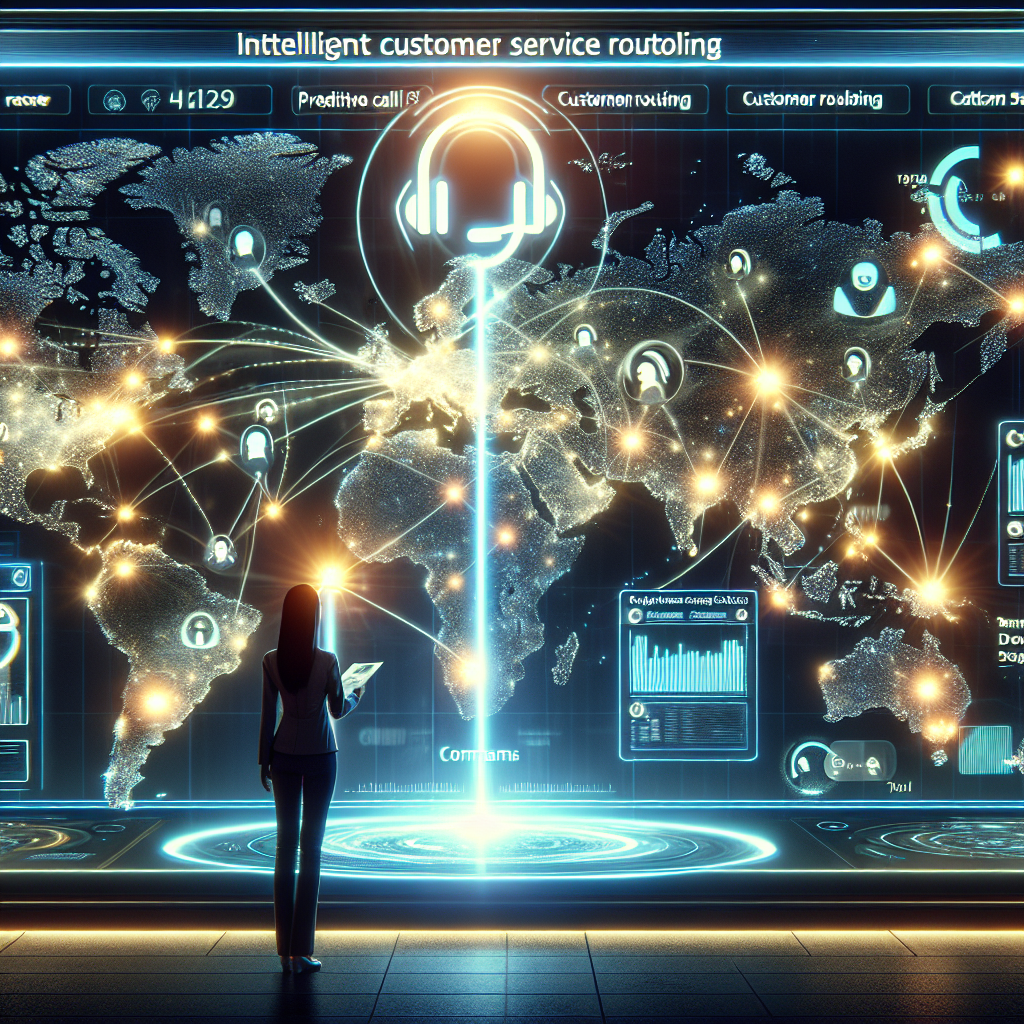
In an era dominated by efficiency and data intelligence, Predictive Call Routing has become an integral part of modern business communications. The technology has a transformative impact on the call center ecosystem, catalyzing seamless customer interactions while minimizing operational complexities. It does so by harnessing the power of Artificial Intelligence.

For the uninitiated, predictive call routing employs AI algorithms to analyze important incoming call variables like customer history, behavioral patterns, intent, and operator skills. With this analysis, it anticipates the perfect match between the customer and call center agent, ensuring a productive and personalized conversation.
The technology dynamically adjusts the routing paths based on past interactions, Real Time Analytics, time of the day, call volume, and other relevant factors. In essence, it enables intelligent decision-making to provide an enriched and optimized customer experience.
Predictive call routing gives businesses a competitive edge, enabling them to not only meet but exceed customer expectations. With AI's potent assistance, businesses can realign their customer engagement strategy to find greater success in retaining customers and fostering loyalty.
As the demand for responsive customer communication continues to rise, technologies that hone the efficiency and quality of these interactions are key. Predictive call routing stands out as a champion in this field, pushing the boundaries of conventional approaches to customer service.
So, let's delve deeper and unravel the potential of predictive call routing in helping businesses actualize their customer relationship goals efficiently.
Understanding the intricacies of predictive call routing requires a comprehensive look into the collection and analysis processes that form its base, which starts not with the call itself but prior. This predictive technology is interlaced with Artificial Intelligence (AI) and Machine Learning capabilities, allowing it to anticipate customer needs based on historical data.
Data Collection forms the bedrock of this system. Intelligent algorithms begin gathering details from the moment a customer engages with a company, including online interactions, past call records, problem history, etc. They meticulously record each interaction and transaction, building a robust data structure.Understanding data collection in AI is key to deciphering how this technology works.
The next step is Data Analysis. After the collection process, predictive call routing employs machine learning algorithms to process and interpret this raw data. It starts identifying patterns, habits, and preferences, which helps the system understand the extent and nature of a customer's needs even before their call is received.
Lastly, the process of Decision Making. The AI-driven platform, armed with the insights derived from data analysis, efficiently routes calls to the most competent agent that can handle the customer's requirements. This eliminates the need for transferring calls multiple times and reduces waiting times, leading to higher customer satisfaction. The science behind this can be understood by exploring how AI aids in decision making.
In essence, predictive call routing transforms the customer service landscape by using AI to anticipate customer needs. It not only speeds up the support process but also makes it more personalized and effective, setting an unprecedented standard of customer care.
In the competitive world of customer service, companies are continually seeking innovative approaches to enhance the client experience and streamline their operations. One emerging technology offering is Predictive Call Routing, an AI-powered system that can significantly transform the way organizations handle customer interactions. By utilizing intelligent analytics and learning algorithms, it allows businesses to anticipate their customers' needs and cater to them more efficiently. Some of the remarkable benefits of predictive call routing include enhanced customer experience, improved efficiency, and reduced response time.
First, predictive call routing provides a superior customer experience. The technology is designed to analyze a customer's history and behavior to predict their needs. This advanced customer profiling includes analyzing past interactions, purchases, and preferences, allowing the system to route each call to the most competent agent to handle their unique needs. Thus, it aids in addressing inquiries efficiently, reducing customer frustration and increasing satisfaction levels.

Another significant benefit involves improved operational efficiency. Predictive call routing streamlines the call routing process, enabling faster and more effective customer support. It minimizes the time spent by agents on calls that are not within their area of expertise, allows more scope for specialization, and reduces customer wait times. This improved efficiency ultimately translates into reduced operational costs.
Finally, there is reduction in response time. A quicker response time is critical in achieving high customer satisfaction scores. Predictive call routing helps achieve this by taking guesswork out of the equation and ensuring that the call lands with the right agent at the first instance. This optimized process leads to reduced hold times, lower abandonment rates, and an overall boost in customer loyalty.
In conclusion, Predictive Call Routing is a powerful tool for any business aiming for superior service delivery. By leveraging this technology, companies can revolutionize their customer service operations, delivering an unmatched customer experience, improving operational efficiency, and reducing response time.
The introduction of predictive call routing in various industries has revolutionized the way businesses handle and manage their customer service operations. Its employment involves innovative artificial intelligence (AI) in making data-driven predictions to forecast customer needs and optimize their journey through customer service protocols. Here, we explore a few case studies that effectively illustrate the real-world implications of this technology.
One significant instance of predictive call routing in action is the case of Amazon. To manage its vast customer base, Amazon utilized predictive routing technology to anticipate customers' concerns based on their online activities and purchase histories. This proactive approach by Amazon saw a dramatic decrease in hold times and greatly improved customer satisfaction rates.
In addition to e-commerce, AI-based predictive call routing has begun to reshape the dynamics in the banking sectors. A noteworthy case was reported by Bank of America. The bank leveraged the technology to scrutinize customer banking and transaction histories, readying their customer service representatives with relevant request or complaint solutions even before a customer made contact. Consequently, the bank reported an increase in customer resolution rates along with an enhanced customer service experience.
The significance of predictive call routing does not stop in the corporate world but extends even to emergency services. In a public sector case study, the New York City's '911' system implemented predictive call routing to cut down on call transferring and promptly presented information to dispatchers. This system triumphed in accelerating emergency responses, ultimately saving more lives.
In conclusion, the application and effectiveness of predictive call routing in these real-world examples offer a glimpse into how AI-enhanced customer service could shape the future of diverse industries.
As the business landscape becomes more digitally oriented, companies are looking for methods to streamline their operations, minimize disruptions, and enhance efficiency. One strategy that has garnered attention is the introduction of predictive call routing, which leverages Artificial Intelligence (AI) to anticipate customer needs. This strategy can significantly reduce waiting times, increase customer satisfaction, and optimize resource allocation.

But how can existing businesses incorporate this modern technology into their current system? The answer lies in understanding the interoperability of predictive call barring with CRM and telecommunications platforms. Both these systems serve as a rich source of data - historical call logs, customer profiles, and interaction history - that AI models require to make accurate predictions. As such, integrating these systems would supply the predictive call routing AI with a wealth of insightful data.
There are several ways businesses can approach this integration. The most straightforward one comprises using API technology. Systems such as Avaya or Amazon AWS provide robust API interfaces for integrating AI capabilities into existing call systems. Another approach entails partnering with cloud-based predictive call routing vendors like Genesys or Five9, that offer integrations with popular CRM platforms. Finally, for those wishing to utilise custom integration, hiring experts in AI and CRM integration would be the route to take.
In conclusion, integrating predictive call routing into existing systems does not need to cause operational disruptions. By aligning the right technologies and partners, this integration can be done seamlessly, transforming call centres into customer engagement hubs.
Remember, the journey towards predictive call routing is a transformative process that extends beyond the phase of technological integration. It involves fostering a culture that understands and appreciates the significance of harnessing AI to enhance customer service – anticipating needs rather than just reacting to them.
The advancements in the field of Artificial Intelligence are set to deeply influence Predictive Call Routing. This technology, built on the fusion of AI and telecom, has been paving the way for personalized and efficient customer service. The future trends in this sector are promising a more predictive and anticipatory approach to customer needs and grievances.
One of the most anticipated advancements in AI-driven call routing is in the area of voice recognition and Natural Language Processing (NLP). This enables the system to better understand caller intent in real-time, thereby providing a much more tailored service. NLP technology in call routing promises to refine speech recognition capabilities making it possible to route calls based on not only keywords but full sentiments expressed during the call.
Additionally, the decision-making algorithms are anticipated to become more sophisticated and accurate. AI systems in the future could potentially hold context-aware conversations, taking into account the history, preferences, and mood of the customer. Context-aware AI conversations would greatly enhance the customer satisfaction and efficiency in the call centers.
In the area of Data Analytics, predictive call routing is slated to see extensive application. By leveraging historical data and employing machine learning models, future AI systems will be able to predict customer behavior and route the call for optimal resolution even before an issue arises. The use of Predictive Analytics ensures faster problem-solving, enhanced customer experience and mitigates the risk of customer dissatisfaction.
Personalization is one more area where future predictive call routing is set to excel. Moving away from standard scripts and responses, AI could help develop personalized conversation starters based on customer's unique preferences, purchasing history or background. AI driven personalization in call routing can potentially significantly improve customer relationships and loyalty.
In summary, the intersection of AI and telecommunications is set to further revolutionize predictive call routing making it more anticipatory, data-driven, personalized and above all, responsive to the evolving needs of customers. The future of predictive call routing is indeed promising.
Start your free trial for My AI Front Desk today, it takes minutes to setup!








